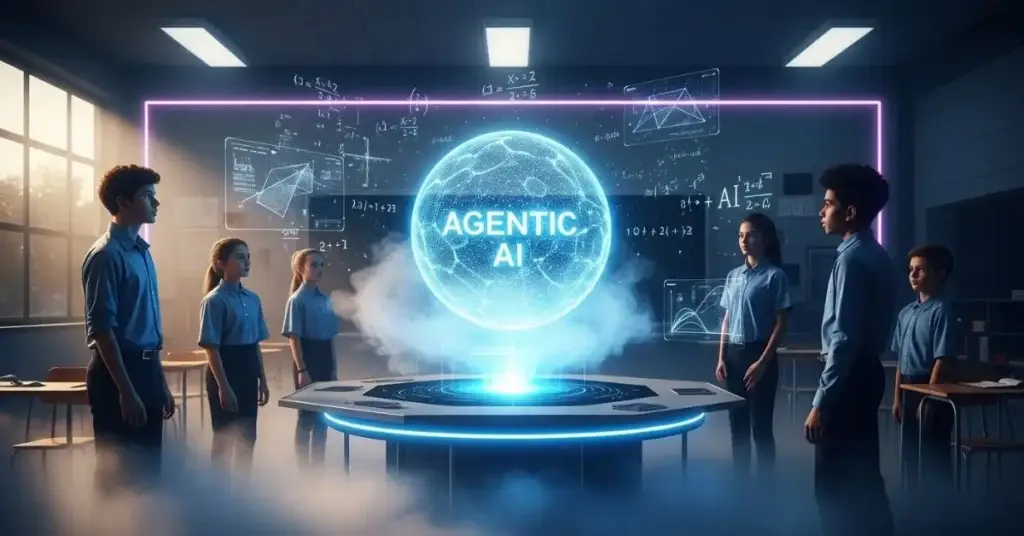
Introduction
AI is no longer just a futuristic concept; it’s already inside classrooms, labs, and universities across the USA and Canada. From AI tutors that guide students in real time to adaptive platforms that personalize lessons, education in North America is experiencing its most significant transformation in decades.
In 2025, the integration of AI is not just about making teaching easier; it’s about preparing students for a world where AI literacy is as essential as reading and writing. Universities like MIT in the USA and the University of Toronto in Canada invest millions in AI-driven research. At the same time, schools use AI tools to boost engagement and improve test scores.
This article explores how AI transforms education in the USA and Canada, the benefits and challenges, and what lies ahead for students, teachers, and policymakers.
Why AI in Education Matters in the USA and Canada?
AI adoption in education is growing faster in the USA and Canada than in most regions.
- Around 86% of schools and universities in the USA now use AI technology.
- In Canada, more than half of college students reported using AI tools like ChatGPT for assignments and research in 2025.
The market growth is also massive. According to research, the Canadian AI in the K-12 education market is set to jump from $27 million in 2024 to nearly $486 million by 2033. Meanwhile, federal funding for AI integration in classrooms in the USA has doubled over the past three years.
AI in education USA 2025 and AI transforming education in Canada are not just buzzwords but real movements shaping how students learn.
Key Applications of AI in Classrooms

1. Personalised Learning
Every student learns differently. AI systems like Khanmigo, ChatGPT, and Google Gemini adapt lessons to a student’s pace. For example, a child struggling with math in a New York high school may get extra practice problems, while a Canadian university student in engineering may get advanced simulations.
This level of personalised learning in North America helps improve retention and confidence among students.
2. Automating Teacher Workloads
Teachers in the USA and Canada often spend 20 – 40% of their time grading and paperwork. With AI tools, repetitive tasks like grading quizzes, preparing lesson plans, and tracking student progress are automated.
In fact, research shows that American teachers who use AI save up to 6 hours weekly. Canadian teachers also report that AI lets them focus more on student mentoring than on administrative tasks.

AI tutors are becoming classroom staples.
- Harvard University uses an AI chatbot called CS50 Duck to help coding students.
- Canadian institutions like McGill University are testing AI-powered assistants for research support.
For students, this means 24/7 help with assignments and guidance that previously only a professor could provide.
Improving Accessibility
AI is used to make classrooms more inclusive in the USA and Canada. Tools like speech-to-text, AI-driven translation, and adaptive software for students with disabilities ensure equal opportunities for all learners.
This aligns with government policies that prioritise accessibility in education across North America.
Benefits of AI in Education
Better Student Outcomes
According to multiple studies:
- Students using AI platforms see up to 62% improvement in test scores.
- Universities report a 12% increase in graduation rates when integrating AI support.
This is especially relevant for students in the USA and Canada, where global competition for high-tech jobs is intense.
Saving Time and Resources
Educators who integrate AI save hours weekly, freeing them to provide human mentorship and creativity-driven teaching.
A Canadian teacher described AI as “the assistant I always wanted, someone who never gets tired of grading.”
Preparing Students for the Future
Employers in both countries now demand AI literacy. Students graduating without AI knowledge risk falling behind. In fact, surveys show that 50% of North American students consider AI skills the most important aspect of their education.
Challenges of Using AI in Education
Over-Reliance on Technology
While AI is powerful, experts warn that too much reliance can weaken critical thinking and creativity. Students may lean on AI for answers instead of developing problem-solving abilities.
Ethical and Privacy Concerns
- In the USA, parents and educators debate whether student data collected by AI is secure.
- In Canada, policymakers worry about algorithmic bias and fairness.
Without proper regulation, AI in education could risk trust and transparency.
Training Gaps for Teachers
A surprising 76% of teachers in the USA reported not receiving proper AI training. Similarly, many Canadian teachers feel unprepared to guide students on responsible AI use.
This highlights the need for AI literacy programs for educators themselves.
Best Practices for Responsible AI in Education
- Train Teachers, Not Replace Them – AI should support, not replace, human educators.
- Establish Ethical Guidelines – Schools must set rules for transparency, bias reduction, and data privacy.
- Focus on Critical Thinking – Encourage students to use AI as a tool, not a shortcut.
- Integrate AI Literacy in Curriculum – USA and Canadian schools need AI-focused courses to prepare students for future careers.
- Monitor & Measure Outcomes – Regularly review how AI impacts performance and engagement.
The Future of AI in Education in the USA and Canada
By 2030, AI is expected to be a core part of education systems in North America. Virtual labs, AI-driven grading, immersive AR/VR classrooms, and fully adaptive curricula are on the horizon.
The key to success will be balance: using AI to make learning more effective while preserving the human connection between teachers and students.
Conclusion
Artificial Intelligence is transforming education in the USA and Canada from classrooms to universities. Providing personalised learning, automating tasks, and preparing students for the AI-powered workforce are redefining how education works in 2025.
However, success depends on responsible use. With proper training, ethical policies, and AI literacy, the future of education in North America looks promising and inclusive.
Want to learn how automation and AI will impact businesses, jobs, and technology in North America? Don’t miss our in-depth article on the AI Automation 2025 Roadmap: Read Now.
FAQs – AI in Education USA & Canada 2025
Q1. How will AI be used in schools across the USA in 2025?
Answer: In 2025, schools in the USA are using AI for personalised learning, grading automation, and student performance tracking. AI-driven platforms adjust lessons based on each student’s pace, helping weaker students catch up and allowing advanced learners to progress faster. Many California, New York, and Texas schools have already integrated AI tutors and adaptive systems, making AI in education USA 2025 a national priority.
Q2. What benefits does AI bring to Canadian education in 2025?
Answer: Canada focuses on AI transforming education using intelligent chatbots, AI tutors, and adaptive platforms that provide bilingual support (English & French). This ensures inclusivity for diverse student groups. AI is also helping Canadian universities conduct intelligent research analysis, enabling faster innovation. Parents and teachers are seeing higher engagement and better student outcomes, which proves that AI transforming education in Canada 2025 is not just a trend but a fundamental shift.
Q3. Will AI replace human teachers in the USA or Canada?
Answer: No, AI will not replace teachers. Instead, it acts as a teaching assistant, helping with repetitive tasks like grading, attendance, and creating lesson plans. Teachers in the USA and Canada use AI to save time and focus more on critical thinking, creativity, and mentorship. This balance ensures that AI supports education without replacing the human connection students need.
Q4. What are the challenges of adopting AI in North American schools?
Answer: The biggest challenges include:
- Data privacy concerns for student information.
- High implementation costs, especially for smaller schools.
- Training teachers to use AI tools effectively.
- Despite these challenges, governments in the USA and Canada fund AI education projects in 2025 to ensure wider adoption.
Q5. How will universities in Canada use AI in 2025?
Answer: Canadian universities like the University of Toronto and McGill use AI tutors, research bots, and predictive analytics to improve student success. AI also helps STEM education by providing simulations, lab support, and real-time data analysis. With these advancements, AI will transform education in Canada in 2025 and create more innovative and research-driven universities.
Q6. Is AI making education more affordable in the USA and Canada?
Answer: Yes. While initial setup costs can be high, AI eventually reduces expenses by automating administrative tasks, providing free AI tutoring apps, and replacing expensive physical resources with digital smart content. Students in the USA and Canada are accessing affordable, personalised learning through AI-driven platforms, which is especially helpful for low-income families.
Q7. What is the future of AI in education beyond 2025?
Answer: Beyond 2025, experts predict that AI will create virtual classrooms powered by immersive technologies like AR and VR, giving students real-world experiences digitally. AI will also make lifelong learning more accessible, meaning even working professionals in the USA and Canada can reskill using AI-driven platforms.


